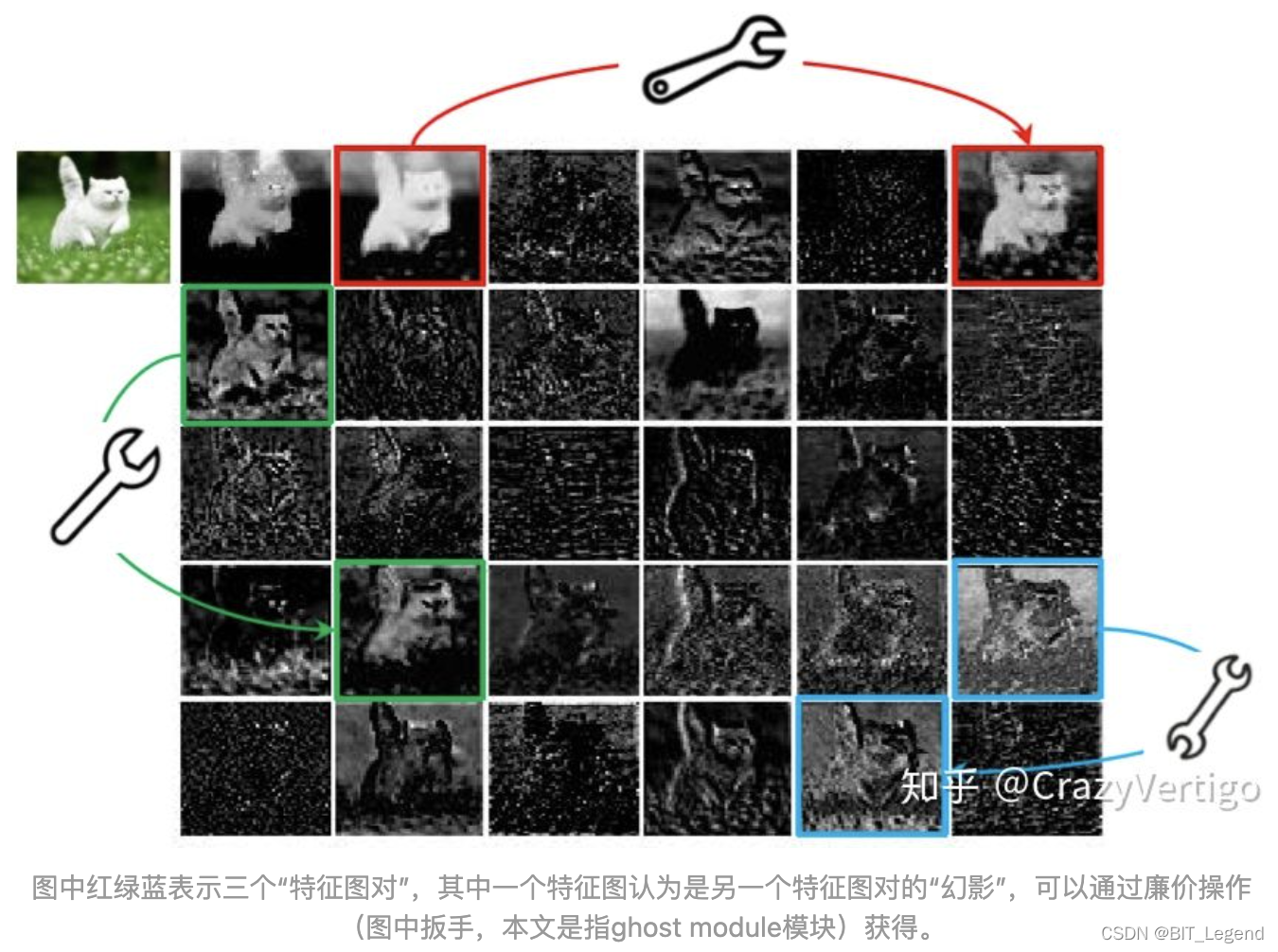ghost模型的效果
GhostNet是为移动设备设计的,文中没有给出在GPU端的开销情况,在华为P30 Pro上进行了GhostNet的实际推理速度测试,并和其他模型进行了对比,所以在GPU上的实际效果还需要测试。和MobileNetV3相比,相同FLOPs的情况下,大约可以提升0.3%~0.5%不等的top-1准确率,相同Latency的情况下,大约可以提升0.5%的top1准确率。在Top1准确率在75%的情况下,GhostNet的Latency大约是40ms,而MobileNetV3大约是45ms。得出结论认为GhostNet总体好于当前的MobileNetV3,MobileNetV2,EfficientNet,ShuffleNetV2,MnasNet,FBNet,ProxylessNAS等网络。【0】


ghost模型实现原理

ghost模型的整个结构照搬了mobilenetv3,只是把基本单元给替换掉了,ghost模型的基本单元如上图所示,将原本的一步卷积变为两步卷积,第一步首先进行常规卷积,但是减少了输出通道数,第二步在第一步的基础上进行深度可分离卷积(仅取第一步),这里深度可分离卷积跟常规深度可分离卷积有点区别,常规深度可分离卷积(仅取第一步)的输入输出通道数完全相等,卷积核数量也等于输入通道数,这里输出通道数可能是输入通道数的整数倍,卷积核数量等于输出通道数。此外,第二步卷积还有并行的一个连接分支,这个分支直接就是第一步卷积的输出。ghost卷积模块的输出通道数等于第一步卷积后的通道数c加上第二步卷积后的通道数n*c,所以最终通道数为(n+1)*c。此操作的依据是经过观察,发现大部分卷积操作后,输出的特征图很多通道之间存在很高的相似性,那我们就可以经过第一步卷积得到那些没有相似性的通道,然后经过第二步卷积得到剩余那些有相似性的通道,可视化如下图:

ghost模型实现代码
ghost模型由华为提出,在github上有官方的torch和tensorflow代码,以下为官方torch代码。
# 官方代码的ghost网络模型 https://github.com/huawei-noah/CV-Backbones
"""
Creates a GhostNet Model as defined in:
GhostNet: More Features from Cheap Operations By Kai Han, Yunhe Wang, Qi Tian, Jianyuan Guo, Chunjing Xu, Chang Xu.
https://arxiv.org/abs/1911.11907
Modified from https://github.com/d-li14/mobilenetv3.pytorch and https://github.com/rwightman/pytorch-image-models
"""
import torch
import torch.nn as nn
import torch.nn.functional as F
import math
__all__ = ['ghost_net']
# 设定整个模型的所有BN层的衰减系数,该系数用于平滑统计的均值和方差,torch与tf不太一样,两者以1为互补
momentum = 0.01 # 官方默认0.1,越小,最终的统计均值和方差越接近于整体均值和方差,前提是batchsize足够大
# 保证v可以被divisor整除
def _make_divisible(v, divisor, min_value=None):
if min_value is None:
min_value = divisor
new_v = max(min_value, int(v + divisor / 2) // divisor * divisor)
if new_v < 0.9 * v:
new_v += divisor
return new_v
# 定义激活函数
def hard_sigmoid(x, inplace: bool = False):
if inplace:
return x.add_(3.).clamp_(0., 6.).div_(6.)
else:
return F.relu6(x + 3.) / 6.
# 定义SE模块
class SqueezeExcite(nn.Module):
def __init__(self, in_chs, se_ratio=0.25, reduced_base_chs=None, act_layer=nn.ReLU, gate_fn=hard_sigmoid, divisor=4, **_):
super(SqueezeExcite, self).__init__()
self.gate_fn = gate_fn
reduced_chs = _make_divisible((reduced_base_chs or in_chs) * se_ratio, divisor)
self.avg_pool = nn.AdaptiveAvgPool2d(1)
self.conv_reduce = nn.Conv2d(in_chs, reduced_chs, 1, bias=True)
self.act1 = act_layer(inplace=True)
self.conv_expand = nn.Conv2d(reduced_chs, in_chs, 1, bias=True)
def forward(self, x):
x_se = self.avg_pool(x)
x_se = self.conv_reduce(x_se)
x_se = self.act1(x_se)
x_se = self.conv_expand(x_se)
x = x * self.gate_fn(x_se)
return x
# 定义基本卷积模块
class ConvBnAct(nn.Module):
def __init__(self, in_chs, out_chs, kernel_size, stride=1, act_layer=nn.ReLU):
super(ConvBnAct, self).__init__()
self.conv = nn.Conv2d(in_chs, out_chs, kernel_size, stride, kernel_size//2, bias=False)
self.bn1 = nn.BatchNorm2d(out_chs, momentum=momentum)
self.act1 = act_layer(inplace=True)
def forward(self, x):
x = self.conv(x)
x = self.bn1(x)
x = self.act1(x)
return x
# 定义ghost模块
class GhostModule(nn.Module):
def __init__(self, inp, oup, kernel_size=1, ratio=2, dw_size=3, stride=1, relu=True):
super(GhostModule, self).__init__()
self.oup = oup
init_channels = math.ceil(oup / ratio)
new_channels = init_channels*(ratio-1)
self.primary_conv = nn.Sequential(
nn.Conv2d(inp, init_channels, kernel_size, stride, kernel_size//2, bias=False),
nn.BatchNorm2d(init_channels, momentum=momentum),
nn.ReLU(inplace=True) if relu else nn.Sequential(),
)
self.cheap_operation = nn.Sequential(
nn.Conv2d(init_channels, new_channels, dw_size, 1, dw_size//2, groups=init_channels, bias=False),
nn.BatchNorm2d(new_channels, momentum=momentum),
nn.ReLU(inplace=True) if relu else nn.Sequential(),
)
def forward(self, x):
x1 = self.primary_conv(x)
x2 = self.cheap_operation(x1)
out = torch.cat([x1,x2], dim=1)
return out[:,:self.oup,:,:]
# 定义ghost网络基本单元
class GhostBottleneck(nn.Module):
""" Ghost bottleneck w/ optional SE"""
def __init__(self, in_chs, mid_chs, out_chs, dw_kernel_size=3,
stride=1, act_layer=nn.ReLU, se_ratio=0.):
super(GhostBottleneck, self).__init__()
has_se = se_ratio is not None and se_ratio > 0.
self.stride = stride
# Point-wise expansion
self.ghost1 = GhostModule(in_chs, mid_chs, relu=True)
# Depth-wise convolution
if self.stride > 1:
self.conv_dw = nn.Conv2d(mid_chs, mid_chs, dw_kernel_size, stride=stride,
padding=(dw_kernel_size-1)//2,
groups=mid_chs, bias=False)
self.bn_dw = nn.BatchNorm2d(mid_chs, momentum=momentum)
# Squeeze-and-excitation
if has_se:
self.se = SqueezeExcite(mid_chs, se_ratio=se_ratio)
else:
self.se = None
# Point-wise linear projection
self.ghost2 = GhostModule(mid_chs, out_chs, relu=False)
# shortcut
if (in_chs == out_chs and self.stride == 1):
self.shortcut = nn.Sequential()
else:
self.shortcut = nn.Sequential(
nn.Conv2d(in_chs, in_chs, dw_kernel_size, stride=stride,
padding=(dw_kernel_size-1)//2, groups=in_chs, bias=False),
nn.BatchNorm2d(in_chs, momentum=momentum),
nn.Conv2d(in_chs, out_chs, 1, stride=1, padding=0, bias=False),
nn.BatchNorm2d(out_chs, momentum=momentum),
)
def forward(self, x):
residual = x
# 1st ghost bottleneck
x = self.ghost1(x)
# Depth-wise convolution
if self.stride > 1:
x = self.conv_dw(x)
x = self.bn_dw(x)
# Squeeze-and-excitation
if self.se is not None:
x = self.se(x)
# 2nd ghost bottleneck
x = self.ghost2(x)
x += self.shortcut(residual)
return x
# 搭建ghost网络模型,整个网络模型完全照搬mobilenetv3,仅仅只是更换了网络基本单元
class GhostNet(nn.Module):
def __init__(self, cfgs, num_classes=1000, width=1.0, dropout=0.2):
super(GhostNet, self).__init__()
# setting of inverted residual blocks
self.cfgs = cfgs
self.dropout = dropout
# building first layer
output_channel = _make_divisible(16 * width, 4)
self.conv_stem = nn.Conv2d(3, output_channel, 3, 2, 1, bias=False)
self.bn1 = nn.BatchNorm2d(output_channel, momentum=momentum)
self.act1 = nn.ReLU(inplace=True)
input_channel = output_channel
# building inverted residual blocks
stages = []
block = GhostBottleneck
for cfg in self.cfgs:
layers = []
for k, exp_size, c, se_ratio, s in cfg:
output_channel = _make_divisible(c * width, 4)
hidden_channel = _make_divisible(exp_size * width, 4)
layers.append(block(input_channel, hidden_channel, output_channel, k, s,
se_ratio=se_ratio))
input_channel = output_channel
stages.append(nn.Sequential(*layers))
output_channel = _make_divisible(exp_size * width, 4)
stages.append(nn.Sequential(ConvBnAct(input_channel, output_channel, 1)))
input_channel = output_channel
self.blocks = nn.Sequential(*stages)
# building last several layers
output_channel = 1280
self.global_pool = nn.AdaptiveAvgPool2d((1, 1))
self.conv_head = nn.Conv2d(input_channel, output_channel, 1, 1, 0, bias=True)
self.act2 = nn.ReLU(inplace=True)
self.classifier = nn.Linear(output_channel, num_classes)
def forward(self, x):
x = self.conv_stem(x)
x = self.bn1(x)
x = self.act1(x)
x = self.blocks(x)
x = self.global_pool(x)
x = self.conv_head(x)
x = self.act2(x)
x = x.view(x.size(0), -1)
if self.dropout > 0.:
x = F.dropout(x, p=self.dropout, training=self.training)
x = self.classifier(x) # 最后的输出层并不包含激活函数,直接就是全链接的输出,在损失函数中包含softmax操作,实际使用需要自己再加一个softmax
return x
def ghostnet(**kwargs):
"""
Constructs a GhostNet model
"""
cfgs = [
# k, t, c, SE, s
# stage1
[[3, 16, 16, 0, 1]],
# stage2
[[3, 48, 24, 0, 2]],
[[3, 72, 24, 0, 1]],
# stage3
[[5, 72, 40, 0.25, 2]],
[[5, 120, 40, 0.25, 1]],
# stage4
[[3, 240, 80, 0, 2]],
[[3, 200, 80, 0, 1],
[3, 184, 80, 0, 1],
[3, 184, 80, 0, 1],
[3, 480, 112, 0.25, 1],
[3, 672, 112, 0.25, 1]
],
# stage5
[[5, 672, 160, 0.25, 2]],
[[5, 960, 160, 0, 1],
[5, 960, 160, 0.25, 1],
[5, 960, 160, 0, 1],
[5, 960, 160, 0.25, 1]
]
]
return GhostNet(cfgs, **kwargs)
if __name__=='__main__':
model = ghostnet()
model.eval()
print(model)
input = torch.randn(32,3,320,256)
y = model(input)
print(y.size())包含训练和测试的完整代码见:https://github.com/LegendBIT/torch-classification-model